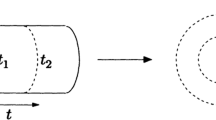Abstract
We are the first to calculate the chiral vortical effect for massless spin 3/2 fields in the framework of the extended Rarita–Schwinger–Adler theory, which contains an interaction with an additional spin 1/2 field. The correspondence with the chiral anomaly and the role of the interaction terms with the additional field are clearly shown. A new versatility has been found that characterizes CVE.
Similar content being viewed by others
REFERENCES
S. L. Adler, “Classical and quantum gauged massless Rarita-Schwinger fields,” arXiv: 1502.02652 (2015).
S. L. Adler, “Analysis of a gauged model with a spin-1/2 field directly coupled to a Rarita–Schwinger spin-3/2 field,” Phys. Rev. D: Part. Fields 97, 045014 (2018); arXiv: 1711.00907.
D. T. Son and P. Surowka, “Hydrodynamics with triangle anomalies,” Phys. Rev. Lett. 103, 191601 (2009); arXiv: 0906.5044 [hep-th].
V. I. Zakharov, “Chiral magnetic effect in hydrodynamic approximation,” Lect. Notes Phys. 871, 295 (2013); arXiv: 1210.2186 [hep-ph] (2012).
D. Kharzeev, K. Landsteiner, A. Schmitt, and H. U. Yee, “Strongly interacting matter in magnetic fields,” Lect. Notes Phys. 871, 1–624 (2013).
Z. V. Khaidukov and R. A. Abramchuk, “Chiral separation effect for spin 3/2 fermions,” J. High Energy Phys. 2107, 183 (2021); arXiv: 2011.13407.
G. Y. Prokhorov, O. V. Teryaev, and V. I. Zakharov, “Chiral vortical effect in extended Rarita-Schwinger field theory and chiral anomaly,” arXiv: 2109.06048 (2021).
D. Zubarev, Nonequilibrium Statistical Thermodynamics Studies in Soviet Science (Consultants Bureau, New York, 1974).
M. Buzzegoli, E. Grossi, and F. Becattini, “General equilibrium second-order hydrodynamic coefficients for free quantum fields,” J. High Energy Phys. 1710, 091 (2017);
J. High Energy Phys. 1807, 119 (2018); arXiv: 1704.02808.
V. I. Zakharov, G. Y. Prokhorov, and O. V. Teryaev, “Acceleration and rotation in quantum statistical theory,” Phys. Scr. 95, 084001 (2020).
M. Stone and J. Kim, “Mixed anomalies: Chiral vortical effect and the Sommerfeld expansion,” Phys. Rev. D 98, 025012 (2018); arXiv: 1804.08668.
G. Y. Prokhorov, O. V. Teryaev, and V. I. Zakharov, “Chiral vortical effect: Black-hole versus flat-space derivation,” Phys. Rev. D: Part. Fields 102, 121702(R) (2020); arXiv: 2003.11119.
ACKNOWLEDGMENTS
The work was supported by Russian Science Foundation, grant no. 21-12-00237.
Author information
Authors and Affiliations
Corresponding authors
Ethics declarations
The authors declare that they have no conflicts of interest.
Rights and permissions
About this article
Cite this article
Prokhorov, G.Y., Teryaev, O.V. & Zakharov, V.I. Chiral Vortical Effect for Spin 3/2. Phys. Part. Nuclei Lett. 19, 467–469 (2022). https://doi.org/10.1134/S154747712205034X
Received:
Revised:
Accepted:
Published:
Issue Date:
DOI: https://doi.org/10.1134/S154747712205034X




